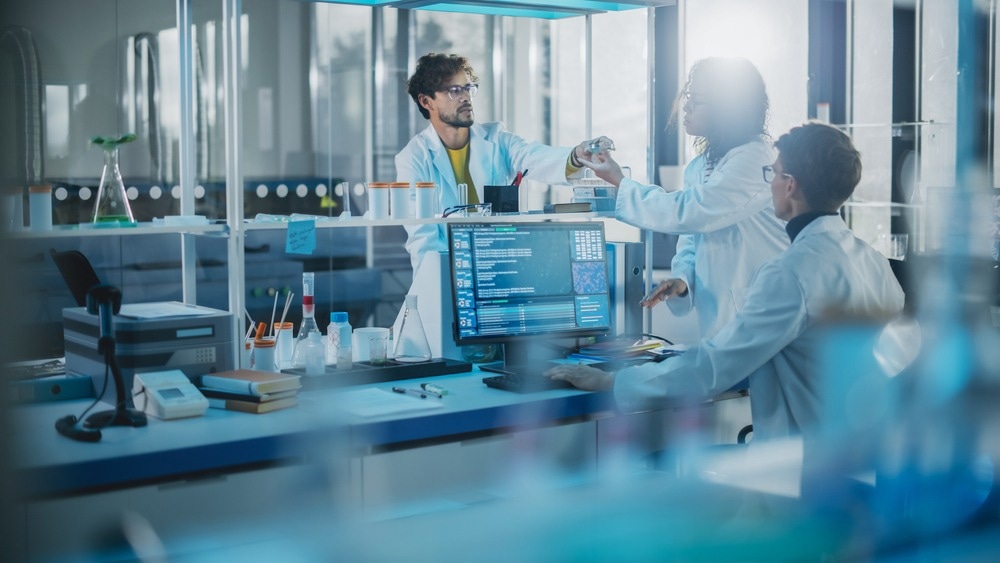A recent study published in the journal Advanced Materials Interfaces presents a surfactant-free approach for dip coating cellulose nanocrystals utilizing hydrotropes.

Study: Investigating Adsorption of Cellulose Nanocrystals at Air–Liquid and Solid–Liquid Interfaces in the Presence of Hydrotropes. Image Credit: Gorodenkoff/Shutterstock.com
Coating a surface with anisotropic nanomaterials like cellulose nanocrystals (CNCs) imparts some of their beneficial physicochemical qualities to the surface, such as toughness, hydrophilicity, and impact resistance. However, the monolayer coatings made of cellulose nanocrystals are influenced by their concentration at both the solid-liquid and air-liquid interfaces.
Adsorbing hydrotropes to cellulose nanocrystals makes them mildly hydrophobic, allowing them to adhere to both air-liquid and solid-liquid interfaces without changing the system's interfacial tension.
Interfacial Behavior of Nanoparticles: An Interesting Research Field
The behavior of nanomaterials at interfaces has piqued the curiosity of many researchers in recent years because of the distinctive physicochemical properties of nano-dimensioned materials afforded by their size. Physically or chemically anisotropic nanomaterials, in particular, have attracted significant attention since their features make them appealing for a wide range of applications.
Anisotropic nanostructures can be compressed more efficiently than their spherical counterparts due to their capacity to align in multiple orientations, thus needing a lower particle density to encapsulate an interface.
This renders anisotropic nanomaterials like rods and disks more successful in Pickering stabilization, which has applications in a variety of sectors such as food, medicines, and cosmetic products.
Hydrotropes for Enrichment of Nanoparticles at Interfaces
Even a trace quantity of surfactant may change the surface potential of anisotropic nanomaterials, altering the intricate balance of forces that govern their behavior on surfaces.
The utilization of nanomaterials as Pickering stabilizers reduces the number of surfactants needed in industrial facilities, further motivating research into alternative compounds that can subtly alter the surface tension of nanomaterials without becoming surface-active themselves.
Hydrotropes, which are small amphiphilic solubilizing compounds, have previously been proven to be a suitable alternative to surfactants for aiding the adsorption of asymmetric graphene oxide nanoparticles at interfaces. This encourages further inquiry into whether hydrotropes may aid in the concentration of other naturally occurring and industrially important anisotropic nanomaterials at surfaces.
Anisotropic Nanoparticle Coatings: Overview and Challenges
Anisotropic nanomaterial coatings are suitable for imparting favorable characteristics to a material surface. Electrical conductivity, heat resistance, and antibacterial activity are examples of such qualities. Coatings containing cellulose nanocrystals have been found to reduce the hydrophilicity of glass substrates while increasing interfacial fracture toughness in glass fiber-epoxy matrix composites.
The most dependable process for producing such coatings is spin coating, which needs specialized equipment and is restricted in terms of the size and configuration of the substrates that can be employed, giving evident hurdles in the expansion of the process. Spray coating and dip coating are two more prominent approaches. They are less dependable if an ordered monolayer is sought but are more flexible and adaptable, with reduced energy costs.
During dip coating, cellulose nanocrystals do not readily adsorb to glass, but they do when a surfactant is applied. Surfactants utilized during coating are expected to be detrimental as nanoscale coating technology develops and is implemented in biomedical domains, owing to their cytotoxicity and propensity for inflammation.
In addition to being biocompatible, biologically-analogous hydrotropes can effectively enrich anisotropic nanoparticles to the solid-liquid and air-liquid interfaces, making hydrotropes suitable targets for adjusting interactions between anisotropic nanomaterials and interfaces.
Highlights and Key Developments of the Current Study
In this study, the researchers described a unique approach for producing monolayer coatings of cellulose nanocrystals on solid surfaces that employ hydrotropes rather than surfactants.
The researchers analyzed these settings to understand the process of dip coating, studying the fundamental mechanism of cellulose nanocrystals at the air-liquid and solid-liquid interfaces under the influence of surfactants and hydrotropes.
Unlike surfactants, which only aided cellulose nanocrystal adsorption at the air-liquid interfaces, hydrotropes aided adsorption at both the air-liquid and solid-liquid interfaces. In the presence of hydrotropes, cellulose nanocrystals are fully absorbed onto the solid-liquid interface in two different layers, resulting in a modular monolayer supported by a more loosely linked outer coating. At the air-liquid interface, only a solitary adsorbed layer could be created, possibly due to resolution constraints.
These benefits, including enhanced flexibility in tuning coating hydrophobicity and lower susceptibility to the air-liquid interface, could pave the way for surfactant-free approaches for the durable and scalable production of anisotropic nanoparticle coatings in the future.
More from AZoNano: How to Synthesize Graphene Quantum Dots
References
Turpin, G. A. et al. (2022). Investigating Adsorption of Cellulose Nanocrystals at Air–Liquid and Solid–Liquid Interfaces in the Presence of Hydrotropes. Applied Materials Interfaces. Available at: https://onlinelibrary.wiley.com/doi/10.1002/admi.202200791
Disclaimer: The views expressed here are those of the author expressed in their private capacity and do not necessarily represent the views of AZoM.com Limited T/A AZoNetwork the owner and operator of this website. This disclaimer forms part of the Terms and conditions of use of this website.